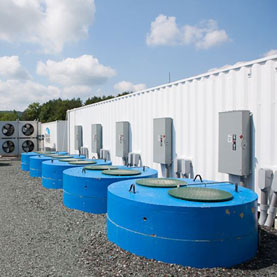The good news is that the flywheels are still making money
Efforts to integrate storage into electric grids continue to struggle as a federally backed flywheel company goes bankrupt
More than 200 tops spin in vessels half-buried in the dirt outside Stephentown, N.Y., a town near the Massachusetts state line. Inside the vessel a vacuum permits each top to rotate as many as 16,000 times per minute, despite the fact that each weighs more than one metric ton, thanks to its steel and carbon-fiber composition. Such fast spinning in a vacuum (to reduce friction) allows each top to store some 25 kilowatt-hours of electricity. When the grid’s frequency gets out of whack—that is, if the 60-times-per-second current should reverse its flow—all the magnetically-levitated tops speed up, slow down or flip direction to ensure the grid stays in tune.
All told, Beacon Power’s flywheels could provide 20 megawatts-worth of such frequency regulation as well as short-term energy storage for the state grid. The only problem is that Beacon’s owner went bankrupt in the process of putting the “alternating” into alternating current—after taking a loan for $39.5 million from the U.S. Department of Energy.
“Our company has been operating at a loss,” Beacon Power CEO Bill Capp said November 1 in prepared statement [pdf] explaining the bankruptcy. “Our goal in taking this action is to minimize job loss and to continue to find ways to apply our innovative technology in the frequency regulation and energy storage markets.”
The good news is that the flywheels are still making money—not enough to keep Beacon in business but enough to potentially pay back the American taxpayer. The flywheels also represent a growing trend in electricity grids worldwide—storage. Sodium sulfur batteries have been used to store electricity from Japan’s grid since 2002 and to back up Xcel Energy’s wind farms in Minnesota since 2008. Molten salts help a power plant in Sicily store the sun’s heat to turn into electricity at night and on cloudy days. Even water pumped uphill at various sites across the U.S. and air compressed into an underground cavern in Alabama, among other places, store electrical energy when it is cheap and give it back when it is expensive. Such storage is considered vital to help intermittent renewable resources, such as the wind and sun, play a bigger role in U.S.—and global—energy supply, but it may be that Beacon’s flywheels are simply too expensive to compete with the other technologies on offer.
“Flywheels don’t typically hold as much energy as batteries,” notes Haresh Kamath, strategic program manager at the Electric Power Research Institute’s Technology Innovation Program—an industry-funded research group. “But they last a very long time and that makes them attractive in some applications, especially where the system is cycled very often—that is, where it is discharged and charged repeatedly across a short time period.”
Read more . . .
Bookmark this page for “electric grid energy storage” and check back regularly as these articles update on a very frequent basis. The view is set to “news”. Try clicking on “video” and “2” for more articles.








